“I called you Blue Roses because you were different… unusual… rare. You were something special… Something I had never seen before.”
– Gentleman Caller, Jim: Tennessee Williams’ “The Glass Menagerie”
AI Gen Process/Software: Humano, ChatGPT.com, Meta.ai, Producer.ai, DAW: Audacity 3.7.5, OS: Linux (Ubuntu 25.04)
 The Sea Remembers Her Name – Full Album + Bonus Track Mix (2:00:22)
The Sea Remembers Her Name – Full Album + Bonus Track Mix (2:00:22)
Free Downloads:
Full Album + Bonus Track Mix – MP3 (320 kbps) – FLAC (Lossless “HD Audio”)
Individual Tracks (128 kbps MP3s)/Images/Narrative Adaptation (Stormborn: The Story of Marisela del Mar) – marisela.zip
Where Afro-Caribbean Rituals, Ambient Storytelling, and Transgender Spirituality Converge in Sound and Myth
“The only reason they tolerated the transgender community in some of these movements was because we were gung-ho, we were front liners. We didn’t take no shit from nobody. We had nothing to lose.”
— Sylvia Rivera
Podcast Google Deep Dive: La Mar Recuerda Su Nombre
 The Sea Remembers Her Name: A Transcendental Garifuna Journey of Identity, Music, and Return
The Sea Remembers Her Name: A Transcendental Garifuna Journey of Identity, Music, and Return
In this feature-length exploration we examine how music, ritual, migration, and transgender spirituality intersect in the story and album “The Sea Remembers Her Name.” This introduction outlines five essential subtopics that illuminate the album’s power: the Garifuna musical roots and heritage that form the rhythmic backbone; the intimate spiritual and gendered journey of Marisela del Mar as an emblematic transgender protagonist; migration and exile as persistent shaping forces on identity and creative expression; the sonic design and production approach—framed here as “Transcendental Garifuna Fusion”—that blends ancestral percussion with ambient electronic textures; and finally performance, ritual, and community impact where club, altar, and street meet. Each of the following sections will unpack these themes in detail, using cultural, musical, and humanistic lenses to illustrate why this work resonates beyond genre and geography. The aim is to provide a clear, readable WordPress-ready article that editors can drop into their CMS and publish with minimal changes.
Garifuna Roots & Musical Heritage
The Garifuna tradition is the album’s ancestral heartbeat: call-and-response vocals, punta and paranda rhythms, and handcrafted percussion unite to ground the music in a specific coastal lineage. These root elements are not window dressing; they function structurally, informing groove, phrasing, and the album’s ritual pacing. Listening closely, one finds turtle-shell timbres, frame drums, and maracas woven through modern synth pads, creating a textured dialogue between past and present. This dialogic layering honors practitioners like Aurelio Martínez and Andy Palacio while allowing new, experimental forms to emerge. Moreover, the Garifuna musical vocabulary carries social memory, prayers, lamentations, and community histories, that the album translates into contemporary sonic language.
Preserving and adapting Garifuna sonic elements requires cultural care: sampling choices, instrumental timbres, and vocal phrasing should respect lineage and avoid exploitation. In practice, that means privileging authentic performers, consulting cultural custodians, and contextualizing any electronic augmentation in liner notes or web copy. When producers and artists engage Garifuna traditions ethically, they help transmit living knowledge to audiences who might never hear these rhythms otherwise. The result can be generative: a wider audience, renewed interest in traditional forms, and new revenue streams for elder musicians and communities. The album modeled here positions itself as both classroom and altar, teaching listeners while inviting them into ritual experience.
Finally, the aesthetic of Garifuna fusion in this project transcends simple genre-tagging, It becomes a political and spiritual statement. Using ancestral rhythms as structural anchors resists homogenizing world-music stereotypes and insists on specificity: this music comes from a Caribbean Honduran coast, not from a generic “island” soundstage. That specificity supports the album’s narrative: music as memory and sea as repository. In web publishing terms, showcasing these roots with embedded audio snippets, artist bios, and contextual images will deepen reader engagement and respect the origin communities’ authorship.
Transgender Spirituality & Marisela’s Journey
At the heart of the album is Marisela del Mar’s intimate, spiritual passage, a transgender woman whose life arc moves from coastal Honduras through exile to diasporic rebirth. Her trajectory offers rich thematic material: naming as resurrection, scarred bodies as holy maps, and ritual gestures that blur the line between survival and sanctification. Marisela’s story reframes the common migration narrative by centering gender transition as both an inward rebirth and a public, political act. This framing allows listeners and readers to experience trans identity as a spiritual vocation rather than merely a social condition.
Music and ritual become the language through which Marisela claims divinity: stage performances double as prayer, fire and water become sacraments, and the red ribbon motif functions as a tangible covenant linking ancestry and selfhood. These images give the album emotional clarity and an operatic scale; the listener perceives not only a biographical arc but also a pilgrimage of the soul. Transgender spirituality in this context asks audiences to re-evaluate notions of holiness, devotion, and embodiment, refusing any simple separation between desire and the sacred. For editors, foregrounding this perspective with quotes, liner-note excerpts, or an artist statement will help readers grasp the moral architecture of the work.
Critically, the treatment of Marisela’s identity is an ethical responsibility: narratives must avoid sensationalizing trauma or reducing the protagonist to a symbol. Instead, journalism and promotional copy should present Marisela’s agency, complexity, and relational ties to community. Embedding interviews with transgender community leaders or citing activist voices, such as Sylvia Rivera for historical resonance, can educate readers and position the album within broader struggles for visibility, dignity, and rights. This approach both humanizes and politicizes the story in ways that deepen the listener’s investment.
Migration, Exile & Identity
The migration thread in the album is not merely a plot device but a sonic and lyrical motif: rivers, borders, and the sea function as liminal spaces where old names are shed and new identities are forged. Each crossing, from La Ceiba to San Pedro Sula, then northward to New Jersey, maps onto a musical transition: from raw foothold rhythms to more urbanized basslines and ambient textures. Sound design mirrors geography: field recordings of surf and rain soften into hums of refrigerators and subway brakes, sonically signaling the move from rural coast to industrial diaspora. These textual cues enable listeners to feel migration as an embodied, acoustic phenomenon.
On a sociocultural level, exile reframes belonging. The protagonist’s attempts to form altars out of found objects, to sing lullabies in another tongue, and to create a community in foreign streets reveal migration as ongoing cultural translation. The album thus becomes a case study in diasporic identity, how memory is preserved, reconfigured, and performed across languages and borders. For readers unfamiliar with Honduran or Garifuna contexts, contextual essays and annotated lyrics aid comprehension and foster respect. Web features like interactive maps and timeline widgets will further help audiences follow Marisela’s passage and understand how geography shapes sentiment.
Finally, the political dimension of migration cannot be ignored: border policies, transphobia, and economic precarity form the material conditions of exile. Presenting these realities within the album’s publicity materials or article write-ups does not diminish its artistic merits; rather, it deepens ethical engagement and can mobilize solidarity. Good editorial practice includes linking to support networks, citing reputable NGOs, and offering resources for readers who wish to act, all while maintaining focus on the album’s artistic narrative.
Sonic Composition & Production: Transcendental Garifuna Fusion
The album’s production style, here named “Transcendental Garifuna Fusion,” blends analog percussion, intimate vocal textures, and modern electronic design to create a cinematic, ritual-ready sound. Production choices emphasize space and resonance: long reverbs, submerged synth pads, and tide-like drones that envelop percussive elements rather than compete with them. This mixing strategy supports the album’s spiritual themes by making the human voice feel like an instrument of the ocean itself. Producers working in this style must carefully balance authenticity and innovation to avoid flattening traditional elements beneath studio gloss.
Arrangements often rely on leitmotifs: a heartbeat drum that recurs as an underpinning motif, the red ribbon expressed musically as a recurring melodic fragment, and ocean samples that act as transitional glue between chapters. These techniques strengthen narrative cohesion and make the listening experience feel like a continuous ritual rather than a disjointed tracklist. On the back end, mastering decisions, preserving dynamic range while maintaining clarity for universal streaming platforms, will affect how emotion translates over earbuds and club systems alike. For WordPress publishing, embedding high-quality streaming players and downloadable not just MP3s but high definition, Lossless options, can widen access while preserving sonic detail.
Collaborative production practices are also central: hiring Garifuna percussionists, consulting cultural bearers, and crediting contributors in full are not just ethical best practices but also artistic advantages. The textures that emerge from live drum recordings, the breath between strokes, the unevenness of human timing, are often the very elements that make such fusion music feel alive. Production notes, session photos, and short documentary clips embedded in the article will lift the project from audio release to cultural artifact.
Performance, Ritual & Community Impact
Performance functions as both survival strategy and sacred act within Marisela’s story: nightclubs become sanctuaries, dances become prayers, and viral videos become unexpected platforms for visibility. The album positions the stage as an intersection where joy and danger coexist, where protest, celebration, and identity formation are all enacted in embodied time. This duality makes the music legible to diverse audiences: club-goers feel the beat and activists hear possibility. When writing about these performances, multimedia documentation helps readers understand their multisensory power.
At the community level, music acts as bridge-building infrastructure: benefit shows, talks, and local workshops tied to the album can catalyze tangible support for transgender and immigrant communities. The narrative of Marisela as a “migrant goddess” or symbol can be harnessed for both art and advocacy, as long as community leaders remain in control of representation. Partnering with local organizations for events, listing donation links in article sidebars, and offering bilingual materials will increase real-world impact and align publicity with ethical aims.
Finally, the album’s long-term cultural effect may be measured not only in streams but in storytelling: in how younger Garifuna and trans artists cite it, in whether elder musicians see renewed interest in their work, and in the conversations it sparks about identity and belonging. For TATANKA’s WordPress editor, tracking engagement metrics will help document the album’s evolving legacy. Thoughtful archiving, including full credits, translations of lyrics, and oral-history notes, all via a mix of Honduran Spanish and English, will ensure the work contributes to cultural memory rather than ephemeral buzz.
Returning, Remembering, and Reframing the Sea
The Sea Remembers Her Name stitches together Garifuna heritage, transgender spirituality, migration, and inventive production into a coherent artistic pilgrimage that speaks to both local specificity and universal longing. Across the five subtopics, musical roots, Marisela’s spiritual journey, migration and exile, production approach, and performance-driven community impact, the album offers a model for how art can be at once devotional and activist. Each thread reinforces the others: ancestral rhythms give ritual authority to the protagonist’s rebirth, migration supplies narrative tension and geographic scale, production choices turn intimate gestures into cinematic moments, and performance translates private devotion into public solidarity. For publishers and readers alike, the work invites careful engagement: listen with context, read with compassion, and amplify in ways that center origin communities and marginalized voices.
Publishers can use this HTML directly in WordPress, pairing the copy with embedded audio, images, and resources to create a multimedia feature. Potential next steps include linking to artist pages, adding an interview with the album’s inspiration, and appending a short resource list for trans and immigrant support organizations. Done well, these additional features wouold not merely promote an album; they would help construct an ethical, enduring conversation about music, migration, and the names we reclaim on the way home, together.
 Musical Genre: “Transcendental Garifuna Fusion”
Musical Genre: “Transcendental Garifuna Fusion”
Definition:
A cinematic, world-ambient fusion blending Garifuna and Afro-Caribbean percussion with ethereal electronic textures, indigenous chants, and narrative-driven songwriting centered on transformation, migration, and spiritual rebirth. It bridges ancestral ritual music, ambient storytelling, and electronic spiritualism, carrying both earthly sensuality and divine transcendence.
Genre Components:
• Root Elements: Garifuna punta and paranda rhythms, Afro-Latin percussion, Andean and Caribbean folk instrumentation.
• Electronic Layer: Ambient synths, downtempo basslines, chill-tribal beats, and cinematic sound design.
• Vocal Approach: Whispered prayers, chants, bilingual (Honduran Spanish & English) lyrics, and Garifuna invocations.
• Thematic Essence: A spiritual pilgrimage through exile, identity, and transcendence, deeply emotional, feminine, and mythic.
• Comparable Aesthetics: If Aurelio Martínez, Björk, Ibeyi, and Nils Frahm collaborated on a sacred concept album about rebirth and migration.
Musical Influences & Preferences
Garifuna Roots & Afro-Caribbean Rhythms
Growing up in a Honduras city like San Pedro Sula or Tegucigalpa, Garifuna music like punta and paranda would have surrounded the cultural landscape.
• Artists: Aurelio Martínez, Andy Palacio (Belizean influence)
• Traits: percussion-heavy, sensual, rhythmic, often about identity, longing, and resilience.
This might resonate with anyone, especially including transgender people navigating identity and belonging.
Sonic Palette
Element/Description
Garifuna percussion
Deep frame drums, maracas, turtle shells, and coastal rhythms evoking ritual and ancestry
Ambient & ethereal synths
To represent the inner transformation and transcendence
Vocal textures
Layered whispers, chants, sighs, merging prayer with breath
Strings (charango, guitar)
Roots of home, warmth, tenderness
Electronic basslines
Urban heartbeat, her American rebirth and sensual power
Emotional Arc
Phase/Song Range/Transformation/Loss & longing
1–3
Facing abandonment, migration, identity rupture
Transformation
4–7
Ritual, fire, sensuality, spiritual awakening
Transcendence
8–10
Integration, divinity, rebirth in her own light
 Title: The Sea Remembers Her Name
Title: The Sea Remembers Her Name
Protagonist:
Marisela del Mar, a Honduran transgender woman, born in La Ceiba, raised near the Garifuna coast. Her name, Marisela, means “born of the sea,” and del Mar (“of the sea”) echoes her connection to origin, cleansing, and return.
She embodies both the tenderness of water and the burning will of fire.
Setting:
The story unfolds between La Ceiba, Honduras (early 2000s) and New Jersey, USA (present day). Time feels fluid, memory, ocean, and dream interlace. The sea becomes her confessor, carrying the songs of her ancestors across borders.
Primary Conflict:
Man vs. Society, her struggle against religious dogma, patriarchal violence, and transphobia.
Man vs. Self, her internal war between shame and divinity.
Man vs. Nature/Spirit, she must reconcile her human fragility with the overwhelming sacred forces she feels within her.
Themes (Between the Lines):
• Rebirth is both violent and holy.
• The divine is not above but within the wounded.
• Migration is a spiritual pilgrimage disguised as exile.
• To name oneself is to resurrect oneself.
 Tracklist
Tracklist
Album Flow Overview: Twelve-Chapter Story Summary
- Birth of Salt
Marisela is born during a tropical storm, her mother screaming that “the sea wants her back.” Her father vanishes into the storm that night. As a child, she feels drawn to the ocean, hearing voices beneath the waves calling her a different name, her true one. - The Red Ribbon
At sixteen, Marisela begins secretly dressing as herself. Her grandmother, a Garifuna healer, ties a red ribbon around her wrist, whispering: “This is your lifeline to the ancestors.” But when her father’s brother discovers her, violence drives her from home. - Woman of Lightning
Fleeing to San Pedro Sula, she finds refuge in a small nightclub run by trans women. There, under stage lights and thunderous music, she renames herself Marisela, “the sea made flesh.” But with every performance, she risks exposure and death. - Flor del Fuego
After a brutal police raid, Marisela survives by hiding under a burning bridge. The fire scars her back, but from the ashes she rises determined: she will leave Honduras, even if it means crossing hell itself. That night, she feels the spirit of her grandmother telling her, “You are not escaping, you are being born.” - Ashes in the Water
She crosses Guatemala and Mexico by bus and by foot, shedding layers of fear, memory, and her old name. In Chiapas, she baptizes herself in a river, saying aloud: “Marisela del Mar.” The water turns red from her wounds, and she smiles. - Luz que Respira
In New Jersey, she finds work cleaning hotel rooms. Alone in her small apartment, she decorates a shrine of candles and seashells. She begins to dream of the ocean singing. She learns English, falls in love briefly with a Dominican cook, and starts to paint her memories of Honduras, the color of longing. - Sacred and Profane
Marisela begins dancing again, not for survival, but for joy. Her performances blend prayer and sensuality. Religious protestors shout outside the club, calling her sinful; she answers with a whispered mantra: “I am both holy and unholy, and still I breathe.” - Migrant Goddess
A viral video of her dancing to a Garifuna rhythm brings her unexpected attention. LGBTQ activists invite her to speak about faith and identity. She resists at first, “I am no prophet”, but the community sees in her something larger, a bridge between worlds. - Prayer in the Mirror
One night she gazes into her mirror and sees not her scars but her reflection illuminated, glowing as if lit from within. She realizes that what she sought in gods and oceans has always been inside her. The sea was never calling her back, it was reminding her she is the sea. - Daughter of Thunder
During a summer storm, Marisela returns to the Jersey shoreline. She stands barefoot in the surf, lightning crowning the horizon. She shouts her name into the storm, “MARISELA DEL MAR!”, and the thunder answers her. For the first time, she feels complete silence inside her mind. - The Language of Ash
She returns to Honduras after decades, visiting her grandmother’s grave. The villagers stare but no longer know her. She ties a new red ribbon to the grave and sings the lullaby her grandmother used to hum, half prayer, half apology. - The Sea Remembers Her Name
At dawn, Marisela wades into the Caribbean surf. The waves rise, shimmer, and fold around her as if embracing a lost daughter. She vanishes into the horizon, not dead, not gone, but dissolved into eternity. The tide brings back a single red ribbon.
01 – Birth of Salt
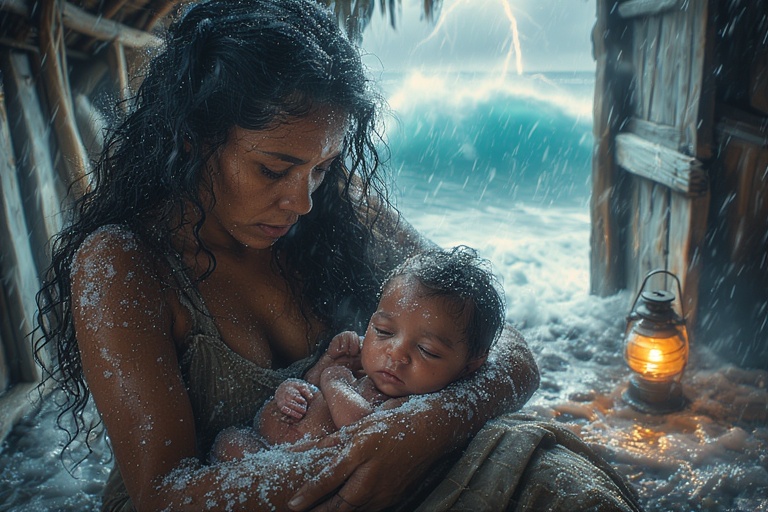
[Verse 1]
Nací en la tormenta, vos
Water broke like the sky
Mi mamá lloraba mientras el viento
sang prophecies through the walls
Los truenos me arrullaron
The rain baptized my skin
Y el océano—tan lejos, tan cerca—
whispered “te conozco, mi hija”
(te conozco)
[Chorus]
¿Por qué la marea knows my name?
¿Por qué la marea knows my name?
¿Por qué la marea knows my name?
before I could speak it myself
[Verse 2]
Dicen que llegué con espuma en los labios
Salt crystals on my tongue
Mi abuela said the waves were calling
desde el golfo, desde antes
The storm wasn’t chaos, no
era un anuncio, a declaration
Cada relámpago wrote my future
on the face of the water
(on the water)
[Chorus]
¿Por qué la marea knows my name?
¿Por qué la marea knows my name?
¿Por qué la marea knows my name?
before I could speak it myself
[Bridge]
Mamá’s tears tasted like the sea
Her blood, my blood, ancient and deep
The tide pulled at her womb that night
Luna llena, birth and prophecy
[Breakdown]
(susurros del océano)
La marea… la marea…
knows me, knows me
[Chorus]
¿Por qué la marea knows my name?
¿Por qué la marea knows my name?
¿Por qué la marea knows my name?
¿Por qué la marea knows my name?
before I could speak it myself
[Outro]
Salt in my veins
Thunder in my bones
La marea still calls
and I’m coming home
02 – The Red Ribbon
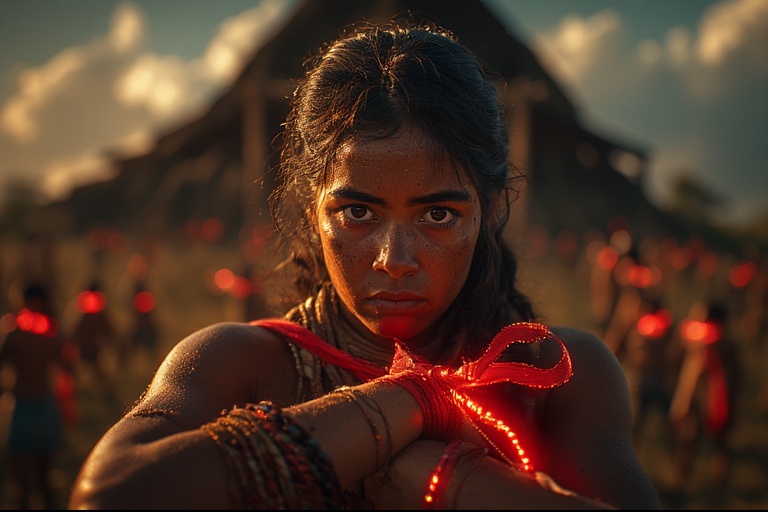
[Verse 1]
Manos viejas
Old hands
Atan
Tie
Tu muñeca
Your wrist
(Seremein, seremein)
[Chorus]
Hilo rojo
Red thread
Hilo rojo
Against the teeth
Hilo rojo
Red thread
Para ti
[Verse 2]
Abuela whispers
Palabras antiguas
Ancient words
En Garífuna
(Aban furendei)
She knows
Ella sabe
The world bites
El mundo muerde
[Chorus]
Hilo rojo
Red thread
Hilo rojo
Against the teeth
Hilo rojo
Red thread
Para ti
Para ti
[Bridge]
Amanecer en tu piel
Dawn on your skin
Carmesí
Crimson
Protección
Protection
(Lidan, lidan, lidan)
She ties love
Ata amor
She ties survival
Ata vida
[Chorus]
Hilo rojo
Red thread
Hilo rojo
Against the teeth
Hilo rojo
Red thread
Para ti
[Outro]
Hilo rojo
Red thread
Hilo rojo
Red thread
(Buiti binafi)
Para ti
Always
Siempre
Para ti
03 – Woman of Lightning

[Intro]
La tormenta toca, truena fuerte
La tormenta vino a verme
[Verse 1]
Renací cuando la luz me parte
Renací bailando en el aire
La luz me toca, me transforma
La luz me encuentra, me reforma
Truena el cielo, tiembla el piso
Truena mi cuerpo, ya lo deciso
Bailo donde nadie baila
Brillo cuando todo falla
Divina entre las llamas blancas
Divina porque nunca me canso
[Chorus]
Renací bajo las luces
Nadie me detiene, yo me luzco
[Verse 2]
La tormenta llama, yo contesto
La tormenta es mía, yo la presto
Luz sobre mi piel, arma bendita
Luz dentro de mí, la más bonita
Bailo y el trueno me corona
Brillo porque esta vida es mi zona
Santo soy cuando me muevo
Santa porque me atrevo
Renací con cada flash brillante
Renací y sigo adelante
[Chorus]
Renací bajo las luces
Nadie me detiene, yo me luzco
[Bridge]
La luz me hizo nueva
La luz es mi prueba
Truena, truena más fuerte
Bailo hasta la muerte
[Chorus]
Renací bajo las luces
Nadie me detiene, yo me luzco
Renací bajo las luces
Nadie me detiene, yo me luzco
04 – Flower of Fire

[Intro]
Yo la vi caer
Yo la vi arder
Pero ahí está
(Yeh, yeh)
[Verse 1]
La conocí cuando todo era normal
Antes que el mundo se pusiera mal
Algo pasó, no sé qué fue
Pero cambió, yo lo noté
La vi quebrada, perdida tal vez
Ceniza en su piel, dolor en su vez
Pensé que se iba a rendir
Pero maje, yo me equivoqué ahí
[Pre-Chorus]
Y ahora que la veo venir
No puedo creer lo que está aquí
Ya no es la misma, no
Algo renació
[Chorus]
Ella se levantó de la ceniza
Ya no hay quien la pise ni quien la divisa
Pétalos de fuego donde camina
La que estaba rota ahora domina
(Prr, prr)
De ceniza a fuego
De ceniza a fuego
(Wuh)
[Verse 2]
Me acuerdo cuando la vi llorando
Todo su mundo se estaba apagando
Pero vos sabés cómo es la vida
Ella tomó la salida
Ya no pregunta, ya no pide
Lo que ella quiere, ella lo decide
Quemó lo viejo para empezar
Y ahora nadie la puede parar
[Pre-Chorus]
Y ahora que la veo venir
No puedo creer lo que está aquí
Ya no es la misma, no
Algo renació
[Chorus]
Ella se levantó de la ceniza
Ya no hay quien la pise ni quien la diviza
Pétalos de fuego donde camina
La que estaba rota ahora domina
(Yeh, yeh)
De ceniza a fuego
De ceniza a fuego
[Rap]
Púchica, déjame contarte bien la historia
Ella llegó del infierno pa’ la gloria
La quemaron viva pero no murió
Se hizo más fuerte, maje, renació
Pétalos cayendo pero son de llama
Todo lo que toca ahora se derrama
Sagrada como templo, intocable
Lo que antes la destruía ahora es parte de su cable
Ceniza en sus manos, fuego en su mirada
Ya no es la que sufre, es la que nada le importa nada
Caminando descalza sobre lo que fue
Dejando huellas de poder donde yo la ví caer
La destrucción fue su maestra
La supervivencia su orquesta
Y el renacimiento su corona
Ahora ella es dueña de su zona
Quemada pero viva, rota pero real
Lo que la mató la hizo inmortal
Pétalos de fuego marcando su paso
Cada cicatriz es un nuevo caso
De cómo se levanta lo que cae
De cómo se salva lo que se deshace
Ella es prueba de que el fuego no mata
Es prueba de que el fuego rescata
[Bridge]
Yo la vi arder
Yo la vi caer
Pero ahí está
Renaciendo otra vez
(Otra vez, otra vez)
[Chorus]
Ella se levantó de la ceniza
Ya no hay quien la pise ni quien la diviza
Pétalos de fuego donde camina
La que estaba rota ahora domina
(Prr, prr)
De ceniza a fuego
De ceniza a fuego
(Wuh, yeh)
[Outro]
De ceniza a fuego
De ceniza a fuego
Ella renació
(Yeh, yeh, yeh)
05 – Ashes in the Water

[Verse 1]
Me duelen los pies desde que salí
El polvo se pega a la piel como culpa
Hay agua adelante, la escucho correr
No sé si es mi sangre o el ruido del mundo
[Verse 2]
Dejé mi nombre en la lengua del río
Y crucé como humo, sin cuerpo ni peso
La corriente se tragó lo que fui
Y la frontera es una mentira que nadie ve
Mis manos temblaban, no sé si de frío
O porque dejé a mi madre llorando en la orilla
[Chorus]
El río se llevó mi nombre
Lo lavó con barro y rezos
Ya no soy la que era antes
Carajo, ya no soy la misma
[Verse 3]
Mi abuela decía que el agua recuerda
Que guarda los muertos y las despedidas
Metí mis pies y sentí cómo ardía
La mezcla de sangre con algo sagrado
No pedí permiso, solo me solté
Y el río me hizo otra, sin preguntarme
[Chorus]
El río se llevó mi nombre
Lo lavó con barro y rezos
Ya no soy la que era antes
Carajo, ya no soy la misma
[Bridge]
Ahora camino y no reconozco mi voz
Me llaman distinto, respondo igual
Lo que dejé atrás se quedó flotando
Y yo sigo aquí, limpia y rota
Libre de una forma que duele
Pero libre al fin
[Chorus]
El río se llevó mi nombre
Lo lavó con barro y rezos
Ya no soy la que era antes
Carajo, ya no soy la misma
[Outro]
(El río se llevó mi nombre)
(Crucé como humo)
(Ya no soy la misma)
06 – Breathing Light

[Intro]
[Acoustic guitar, fingerpicking]
[Verse 1]
Me levanto antes del sol
Enciendo una vela
Todavía no sé por qué
La cocina está fría
Mis pies descalzos
El silencio pesa
[Chorus]
Cada respiro es una oración
Que olvidé que sabía
[Verse 2]
Las conchas en la ventana
No huelen a nada
En el zumbido del refrigerador
Escucho el mar
Mis manos arreglan cosas
Pequeños altares sin nombre
[Chorus]
Cada respiro es una oración
Que olvidé que sabía
[Bridge]
No hay nadie mirando
Pero me arrodillo igual
La divinidad está aquí adentro
En estos gestos que nadie ve
[Verse 3]
Lavar los platos
Es bautismo ahora
Barrer el piso
Es bendecir
Cada cosa común
Se vuelve santa
[Chorus]
Cada respiro es una oración
Que olvidé que sabía
[Outro]
La vela se apaga
Yo sigo
[Guitar fades]
07 – Sacred and Profane
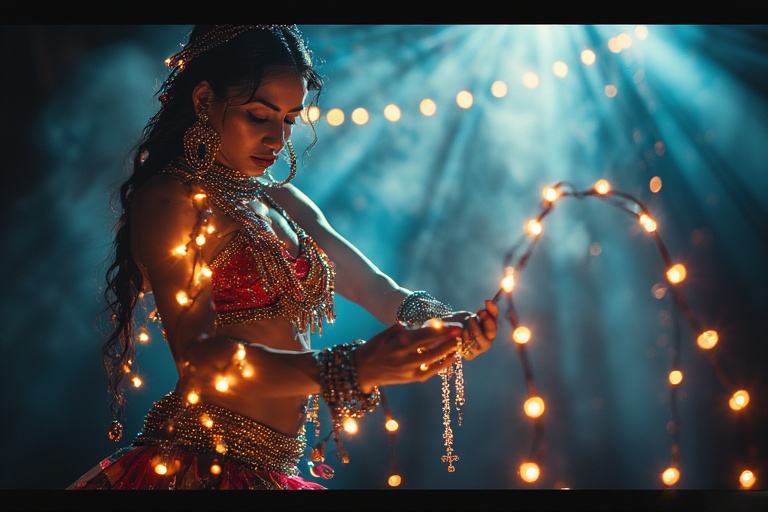
[Verso 1]
Cuando me mirás así
Sé que querés entrar
Pero mi cuerpo es templo, mirá
Y vos tenés que arrodillar
Mis caderas rezan más fuerte que las campanas
Mi sudor es incienso
Cada movimiento una oración
¿O acaso no lo sentís?
[Pre-coro]
Toco mi piel como liturgia
Mis labios son bendición
No me vengas con tu culpa
Esto es devoción
[Coro]
¿Me ves rezar cuando bailo?
¿O sólo ves lo que querés ver?
[Post-coro]
(¡Ey!)
Así, así mismo
¿Me ves? ¿Me ves?
[Verso 2]
Tu cama puede ser altar
Si sabés cómo adorar
No hay pecado en este fuego
Es sagrado, carajo, es real
Cada gemido es confesión
Cada beso comunión
No separés lo que soy
Deseo y santidad en una sola voz
[Pre-coro]
Toco mi piel como liturgia
Mis labios son bendición
No me vengas con tu culpa
Esto es devoción
[Coro]
¿Me ves rezar cuando bailo?
¿O sólo ves lo que querés ver?
[Post-coro]
(¡Ey!)
Así, así mismo
¿Me ves? ¿Me ves?
[Puente]
No necesito tu permiso
Para ser divina
Mi cuerpo habla en lenguas
Que vos no entendés todavía
Pero si te quedás quieto
Y me escuchás de verdad
Vas a ver que mi placer
Es mi forma de rezar
[Coro]
¿Me ves rezar cuando bailo?
¿O sólo ves lo que querés ver?
[Post-coro]
(¡Ey!)
Así, así mismo
¿Me ves? ¿Me ves?
(Mirá bien, mirá)
08 – Migrant Goddess
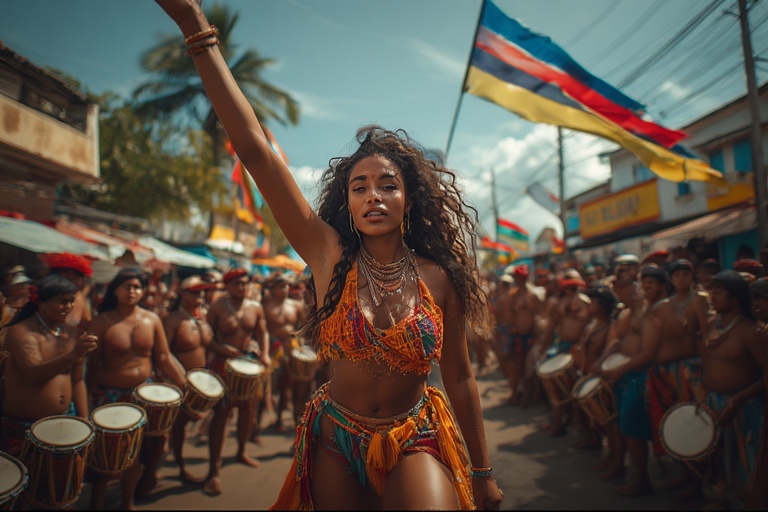
[Verse 1]
Maje, me miran distinto
Cada vez que hablo
No sé qué pasó
Pero ya no camino sola
[Pre-Chorus]
Nunca pedí esto
Nunca lo busqué
[Chorus]
¿Quién me coronó?
¿Quién me coronó?
[Post-Chorus]
Freedom, freedom
Rise up, rise up
Libre, libre
Vaya pues
[Verse 2 – Rap]
Yo solo caminaba en mi verdad, maje
Yo solo hablaba sin pensar en nadie
Yo solo existía, pija, respirando fuerte
Yo solo decía lo que todos sienten
De repente hay ojos, de repente hay gente
De repente soy la voz que representa
No profeta, solo pulso
Pero igual me coronan
Nunca fui bandera pero así me toman
Nunca dije “síganme” pero igual me buscan
La comunidad decide, yo no me la juego
Ahora cargo peso que yo no escogí primero
[Chorus]
¿Quién me coronó?
¿Quién me coronó?
[Post-Chorus]
Freedom, freedom
Rise up, rise up
Libre, libre
Vaya pues
[Breakdown]
(Yeh, wuh)
¿Quién me coronó?
(Prr)
Ustedes lo hicieron
¿Quién me coronó?
Ustedes decidieron
[Bridge]
Pues bien
Si me ven así
Acepto el trono
Pero sigo siendo yo, maje
Sigo siendo pulso
Sigo siendo real
[Chorus]
¿Quién me coronó?
¿Quién me coronó?
[Post-Chorus]
Freedom, freedom
Rise up, rise up
Libre, libre
Vaya pues
[Outro]
Ustedes me coronaron
Y vaya pues
Aquí estoy
09 – Prayer in the Mirror

[Verse 1]
Me paro aquí
frente al cristal
La luz entra
No sé qué más
[Chorus]
Veo a Dios
se parece a mí
Veo a Dios
se parece a mí
[Verse 2]
Tengo miedo
de mirar
Mis propios ojos
¿Qué van a hablar?
[Chorus]
Veo a Dios
se parece a mí
Veo a Dios
se parece a mí
[Verse 3]
Ya no huyo
Me quedo aquí
Respiro hondo
Puedo sentir
[Chorus]
Veo a Dios
se parece a mí
Veo a Dios
se parece a mí
[Breakdown]
(Veo a Dios)
(se parece a mí)
(Veo a Dios)
(se parece a mí)
[Solo]
[Acoustic guitar]
[Chorus]
Veo a Dios
se parece a mí
Veo a Dios
se parece a mí
[Outro]
Se parece a mí
Se parece a mí
Siempre estuvo aquí
10 – Daughter of Thunder
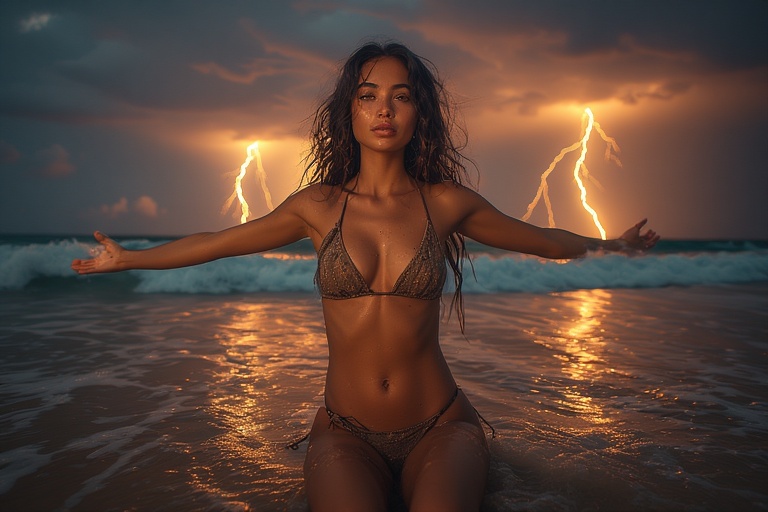
[Verse 1]
Ya pasó la tormenta
Mis pies en la arena
El viento me llama
Las olas me hablan
Todavía tiemblo
Pero aquí estoy de pie
[Chorus]
Grito mi nombre al cielo
Y el trueno me responde
[Verse 2]
Las nubes se rompen
El agua en mi cara
Ya no tengo miedo
De lo que viene
Levanto mis manos
La lluvia me limpia
[Chorus]
Grito mi nombre al cielo
Y el trueno me responde
[Pre-Chorus]
Soy parte del viento
Soy parte del mar
Ya no me escondo más
[Solo]
[Verse 3]
Miro hacia arriba
Y grito más fuerte
Mi nombre completo
Sin vergüenza
El relámpago escribe mi nombre en el cielo
Y la tormenta se inclina
[Chorus]
Grito mi nombre al cielo
Y el trueno me responde
[Bridge]
Ya no soy la misma
Que llegó temblando
Ahora soy la fuerza
Soy el relámpago
Soy la tormenta
Y también la calma
[Chorus]
Grito mi nombre al cielo
Y el trueno me responde
[Chorus]
Grito mi nombre al cielo
Y el trueno me responde
[Outro]
Aquí estoy
Aquí estoy
El mar me conoce
El cielo me conoce
Ya saben quién soy
11 – The Language of Ash
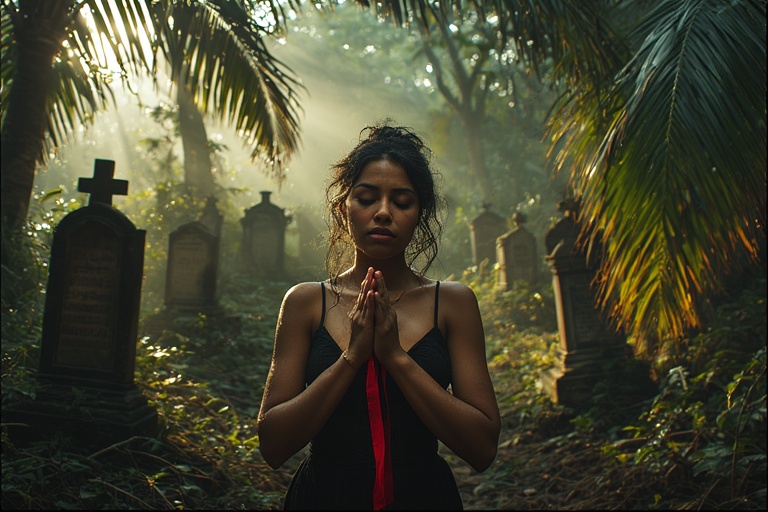
[Verse 1]
La tierra está caliente aquí
The dust remembers me, I think
Pongo algo en el suelo
Something red, something small
[Pre-Chorus]
Oh, oh
¿Me perdonás?
Oh, oh
¿Me perdonás?
[Chorus]
¿Me perdonás, abuela?
¿Me perdonás?
The wind says something soft
¿Me perdonás, abuela?
¿Me perdonás?
I’m kneeling in the grass
[Verse 2]
Your hands were rough, I remember
Smelled like tortillas and soap
I was pequeña, so pequeña
You braided my hair in the morning
[Pre-Chorus]
Oh, oh
¿Me perdonás?
Oh, oh
¿Me perdonás?
[Chorus]
¿Me perdonás, abuela?
¿Me perdonás?
The wind says something soft
¿Me perdonás, abuela?
¿Me perdonás?
I’m kneeling in the grass
[Rap]
Te traigo el listón otra vez como antes cuando era niña y vos me querías tanto
I was gone so long abuela and I don’t know if you understand why I couldn’t stay
There were years between us, años de silencio que no pude romper aunque pensé en vos
Every birthday every holiday I saw your face pero no pude volver hasta ahora
Now I’m here con mis manos vacías except for this ribbon this red piece of then
[Bridge]
The stone is warm
My knees are dirt
I hear you, creo que te oigo
[Chorus]
¿Me perdonás, abuela?
¿Me perdonás?
The wind says something soft
¿Me perdonás, abuela?
¿Me perdonás?
I’m kneeling in the grass
[Outro]
Oh, oh
¿Me perdonás?
Oh, oh
I think you do
Oh, oh
¿Me perdonás?
The ribbon stays with you
12 – The Sea Remembers Her Name
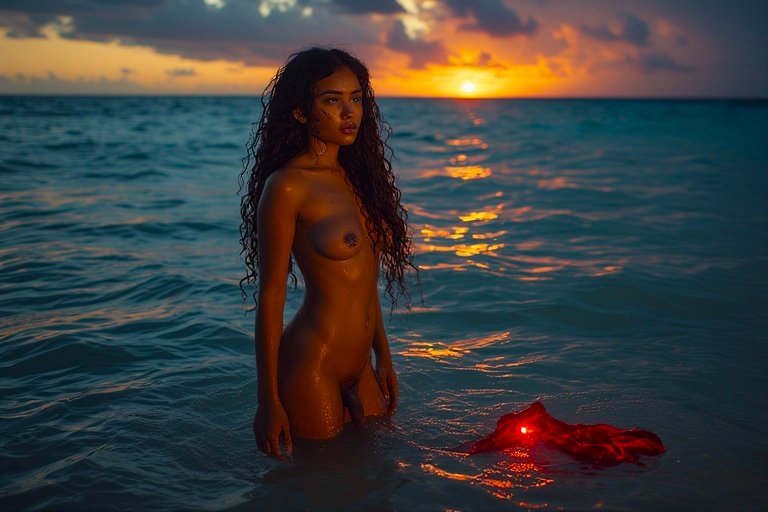
[Verse 1]
Mis pies en la arena
My feet fade
Soy sal
Soy espuma
I let go
[Verse 2]
Las olas me llaman
The water knows
Mi nombre se borra
I breathe below
Soy mar
[Chorus]
Soy mar
I return
I am the tide remembering
Soy mar
Sin fin
I am the wave returning
[Verse 3]
Mis manos se abren
My palms release
La costa me suelta
The shore lets me be
Soy paz
[Verse 4]
Mi piel se disuelve
My bones turn soft
Soy sueño del agua
I am the ocean’s breath
Soy todo
[Chorus]
Soy mar
I return
I am the tide remembering
Soy mar
Sin fin
I am the wave returning
[Bridge]
Agua en mis venas
Salt in my soul
Me fundo, me quedo
I lose, I’m whole
[Verse 5]
No hay yo
No hay límite
Solo este azul
This blue forever
Soy esto
[Chorus]
Soy mar
I return
I am the tide remembering
Soy mar
Sin fin
I am the wave returning
[Outro]
Soy la marea
I am home
Soy la marea
(Soy mar)
I am home
(I return)
[Instrumental Coda]
Bonus Track – Sacred Fire of the Sea (Extended Club Mix)
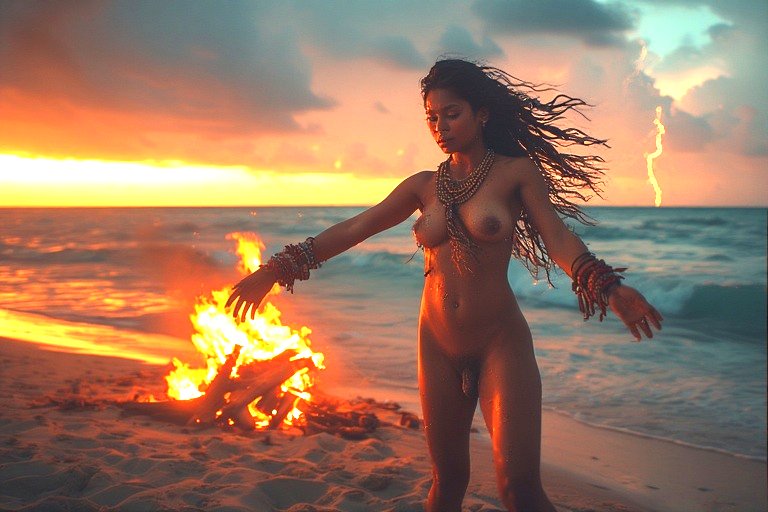
For Marisela del Mar, the dance floor is more than escape, it is ritual, rebirth, and revelation. She is a woman forged from storms, fire, exile, and return. When she dances, she doesn’t seek the generic drops of international EDM; she seeks a rhythm that remembers her, one that binds sweat to tide, neon to lightning, and body to spirit.
This track, a mix of remixes of the original track, fuses the ancestral heartbeat of Garifuna drums with the heavy sub-bass of urban nightlife, creating a pulse that is both ancient and immediate. Afro-house atmospheres and tribal house grooves transform the club into a temple, a space where trance and sensuality intertwine. Moombahton and reggaetón-techno elements drive hips and feet forward with unapologetic urgency, while oceanic pads and whispered chants dissolve the dancer into something larger than flesh, a tide, a flame, a force of nature.
The final sections cool down the heat, allowing the listener, or dancer, to find their peaceful and serene center, ideally leading and returning to the first track of the album.
Sacred Fire of the Sea is Marisela’s baptism by rhythm, her midnight communion of storm and body. It is not simply music to dance to, it is music to become within.
[Intro – Whispered]
(La marea recuerda mi nombre)
(La marea recuerda mi nombre)
[Verse 1]
Pista, vos me mirás
Te pido permiso para transformar
Agua y aire en mi piel
Bailo hasta romper
[Pre-Chorus]
Soy mar
Soy fuego
Bailo libre
Sin miedo
[Chorus]
Soy mar, soy fuego, bailo libre, sin miedo
Soy mar, soy fuego, bailo libre, sin miedo
(Aban aban, weyu weyu)
Soy mar, soy fuego, bailo libre, sin miedo
(Aban aban, weyu weyu)
[Verse 2]
Pista, testigo sagrado
Mi cuerpo crece como oleada
Furiosa, feroz, flamante
Libre adelante
[Pre-Chorus]
Soy mar
Soy fuego
Bailo libre
Sin miedo
[Chorus]
Soy mar, soy fuego, bailo libre, sin miedo
Soy mar, soy fuego, bailo libre, sin miedo
(Aban aban, weyu weyu)
Soy mar, soy fuego, bailo libre, sin miedo
[Breakdown – Whispered]
(La marea recuerda mi nombre)
(La marea recuerda mi nombre)
(Garifuna gubida, protege mi alma)
(La marea recuerda mi nombre)
(Garifuna gubida, protege mi alma)
[Rap]
Pista, te cuento un secreto en este mensaje
Cada paso es pasaje, cada vuelta es salvaje
Me transformo en tormenta, toda potente, presente
Agua ardiente en mi mente, soy la corriente
Te hablo directo: respeto mi reflejo
Bailo sin complejo, lejos de lo viejo
Soy sirena, soberana, sustancia sagrada
Sangre salada, salvada, sanada
Fuego y furia, fe y fuerza
Mientras muevo esta marea que atraviesa
[Bridge]
(Call) Soy mar
(Response – Aban weyu)
(Call) Soy fuego
(Response – Aban weyu)
Bailo
Libre
Sin miedo
Sin miedo
Sin miedo
[Chorus – Final]
Soy mar, soy fuego, bailo libre, sin miedo
Soy mar, soy fuego, bailo libre, sin miedo
(Aban aban, weyu weyu)
Soy mar, soy fuego, bailo libre, sin miedo
(La marea recuerda mi nombre)
[Outro – Whispered]
(La marea recuerda mi nombre)
(Sin miedo)
(Sin miedo)
[Remixes]
[Reprise/Coda] “Ya Soy Libre”
[Intro]
Ya llegué
Ya soy libre
(Yeh)
Mi futuro brillante
[Verse 1]
Ya me voy
Ya me fui
Ya me siento viva así
Ya rompí
Ya salí
Ya mi cielo está aquí
Ya no hay
Nada más
Que me pueda detener
Ya mi paz
Ya mi luz
Ya me voy a mover
[Pre-Chorus]
Yo voy
Yo vuelo
Yo sé que todo es mío
Yo voy
Yo quiero
Vivir mi desafío
[Chorus]
Ya soy libre, libre, libre
Todo lo que quiero es mío
Ya soy libre, libre, libre
Vos mirá cómo yo brillo
(Prr)
[Verse 2]
Ya encontré
Ya sentí
Todo el amor que pedí
Ya logré
Ya viví
Todo lo que merecí
Ya subí
Ya llegué
A la cima sin temer
Ya reí
Ya amé
Y ahora voy a vencer
[Pre-Chorus]
Yo voy
Yo vuelo
Yo sé que todo es mío
Yo voy
Yo quiero
Vivir mi desafío
[Chorus]
Ya soy libre, libre, libre
Todo lo que quiero es mío
Ya soy libre, libre, libre
Vos mirá cómo yo brillo
[Outro]
Ya llegué
Ya soy libre
(Yeh)
Mi futuro brillante
Ya llegué
(Ya llegué)
Ya soy libre
(Ya soy libre)
Brillante
(Brillante)
[Ambient Resolution – El Final y el Comienzo]
Narrative Adaptation: Stormborn: The Story of Marisela del Mar (PDF)
Click for full-size image, and divine beauty:
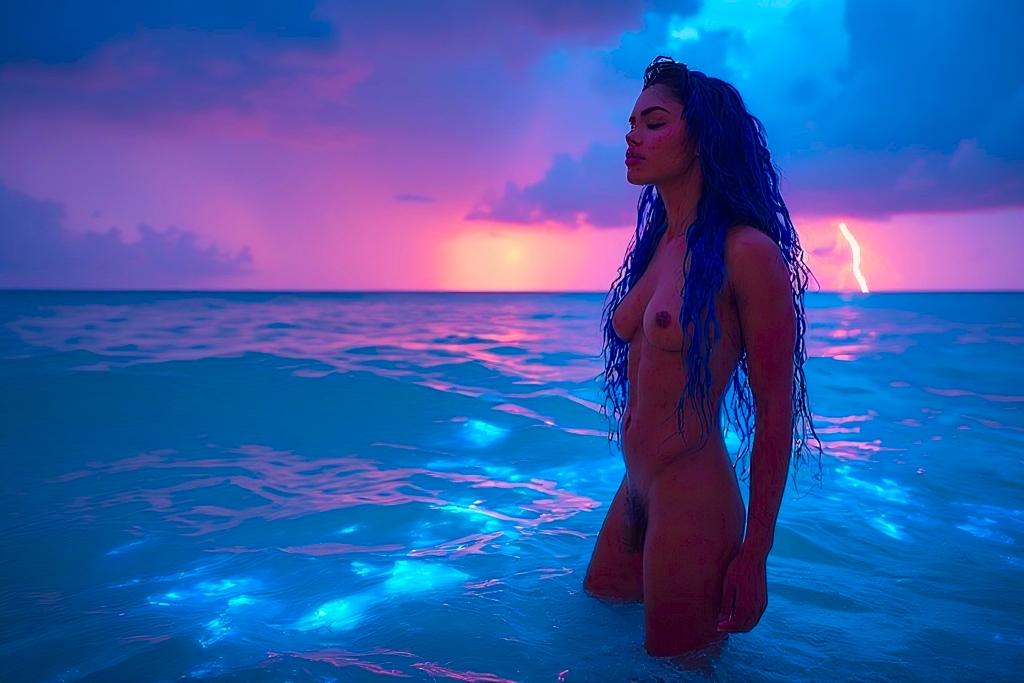
Chapter 1 – Birth of Salt
The night Marisela was born, the sea clawed its way onto the land. Wind howled like a chorus of forgotten saints, and the rain beat against the tin roof of the small wooden house as if demanding entry. Her mother labored in pain and terror, whispering prayers that drowned beneath the storm’s roar. “The sea wants her back,” she gasped, her eyes wide and fevered as thunder fractured the heavens. The midwife crossed herself and looked toward the black horizon. Outside, a lone lantern flickered and went out, the last human light before the ocean swallowed the village’s silence.
Her father was seen one final time that night, running barefoot toward the cliffs, a torch in his hand. Some said he went to calm the sea; others believed he followed a voice only he could hear. When dawn broke, the storm had vanished as swiftly as it came. The world was clean and gleaming, and a newborn child lay quiet in her mother’s arms, skin glistening with fine salt crystals, as though the waves themselves had anointed her. Her father was never found. Only his torch washed ashore, its wood warped and pale as bone.
Marisela grew up in that small coastal village where the sea was both god and ghost. The elders spoke of her in murmurs, calling her la hija del mar, the daughter of the sea. They said the ocean had claimed her before she ever took her first breath. When other children built sandcastles, she traced strange symbols in the wet sand, spirals that seemed to pulse faintly before being swept away by the tide. Sometimes she would stare into the horizon for hours, her lips moving as if in conversation with something far beneath the waves.
As she grew older, the whispers beneath the water grew clearer. They called her a name not her own, Arenai, a name that shimmered like light through blue glass. She never told anyone, not even her mother, who avoided the sea and crossed herself whenever thunder rolled. At night, Marisela would wake to the rhythmic hush of the tide, her heart thrumming in time with its pull. The ocean’s voice came to her in dreams: You were not born; you returned.
By the time she was twelve, Marisela knew that her destiny was not entirely human. There was something ancient within her blood, a memory older than language, something the sea remembered even when she could not. Standing barefoot on the wet sand, she would whisper her secret name to the waves and feel them rise in answer, each swell a heartbeat echoing her own. And though she was afraid, she also felt an ache that was almost love, as if the storm that had taken her father and blessed her birth had not ended at all, but simply waited, patient and eternal, in the deep.
Chapter 2 – The Red Ribbon
Marisela’s adolescence arrived like a tide, slow and relentless, carrying with it a restless longing she could not name. The villagers began to notice her difference, a fragility wrapped in fire, a gaze that lingered too long on the curves of women, the shimmer of silk, the whispers of the ocean. At sixteen, her body began to insist upon truths that society would not yet name, and she felt both terrified and exhilarated. Her grandmother, a quiet woman with hands knotted from decades of work and ritual, saw the stirrings long before anyone else. One evening, under a ceiling of stars trembling above the shore, she called Marisela to her side.
From a small, carved wooden box, the grandmother produced a red ribbon, vibrant and unbroken, as if it had been plucked from the heart of a sunset. She tied it carefully around Marisela’s wrist, murmuring in Garifuna a prayer older than the hills, a chant to the sea, the ancestors, and the child who was already more than a child. “This thread,” she said, “is your lifeline to the spirits who walk unseen. Wear it when the world wants to erase you.” The ribbon felt alive against Marisela’s skin, pulsing with warmth and the faint taste of salt. That night, the wind carried whispers of encouragement, as if the ocean itself had learned her name and was speaking it back.
Yet danger lurked as sharply as beauty. Her father’s brother had eyes like hawks and a heart sharpened by fear. He discovered Marisela in a borrowed dress, laughing quietly at the mirror, brushing her hair until it shimmered like wet night. Rage and confusion flared, and his words were a storm itself, battering the child’s fragile armor. Marisela fled into the forest beyond the village, the red ribbon tight around her wrist, each step sinking into the wet earth as if marking her passage into another life. Every leaf seemed to bend in recognition, every tree murmuring, She is becoming.
That night, she curled beneath a copse of palms, listening to the ocean’s roar, letting the waves’ rhythm fill the hollow spaces in her chest. She whispered the name that had begun to root itself in her heart, Marisela del Mar, and felt it bloom, fragile and bright, like coral kissed by dawn. The ribbon around her wrist shivered in answer, and for the first time, she imagined that she might survive the storms of the world. Even when fear gnawed at her, the memory of the ribbon and her grandmother’s chant anchored her to something greater than herself, a promise that no force of anger or hatred could entirely sever.
By the time the first light crept over the horizon, the village had not noticed her absence. Marisela returned at dawn, silent and watchful, carrying within her the quiet assurance of the red ribbon. She walked past the houses, past the judgmental glances and murmurs, and toward the sea, which now seemed more alive than ever. The ocean, vast and indifferent, had whispered her truth once again: she was not only of this world; she belonged also to the tides, the salt, the wind, and the ribbon was the first tangible proof of her covenant.
Chapter 3 – Woman of Lightning
The night Marisela first stepped onto the small stage in San Pedro Sula, the air itself seemed to hold its breath. Neon lights bled across the walls like liquid jewels, pooling in the corners and illuminating the sweat and smoke of the nightclub. The crowd’s murmur rose and fell like waves, a rhythm she could feel in her bones, vibrating with the pulse of the city and the storm that had been her cradle. Every step she took was deliberate, measured against the invisible tide of history and longing that she carried within her chest.
The storm outside mirrored her own heart, lightning cleaving the sky, thunder rattling the windows, as if the heavens themselves demanded she show the world who she truly was. Marisela moved with a grace that seemed impossible for one so young, limbs weaving a tapestry of fire and water, of anguish and delight. Each turn, each sway, was an invocation, a spell, a defiance. The crowd’s gaze was electric, hungry, uncertain; yet she saw through it, past it, into the pulse of the night. She felt the ancestors in the walls, in the drums, in the wind scraping against broken panes.
Backstage, she could hear whispers, some in awe, some in judgment, others in fear. But the red ribbon on her wrist throbbed with reassurance, a heartbeat she could feel more keenly than her own. Marisela whispered her secret name, Arenai, under her breath, and in that private utterance, the stage became a sacrament. She was not merely performing; she was calling down the lightning to mark her passage. Every note of the song she sang, every flex of muscle and flash of eye, was a step toward the person the ocean had always known her to be.
The crowd erupted, a wave of sound that crashed against her like the tides she had known as a child. Some were angry, some bewildered, some intoxicated by her audacity; yet Marisela did not falter. She let the storm outside merge with the storm inside, letting each clap and cheer carry away the weight of the fear that had haunted her since birth. Her body became a conduit, a bridge between human and divine, electric with the knowledge that she had survived, that she had conquered, and that she could never return to the girl who had crouched in the forest clutching a ribbon.
When the music ended, sweat beaded along her temples, and she felt the quiet reverence of the night settle like a gentle tide. She looked out over the faces, the bright neon, the shadows, and saw that something had shifted, not in them, perhaps, but in herself. Lightning had struck, yes, but not just outside; it had struck the marrow of her being, igniting a certainty she could never again unlearn: she was Marisela del Mar, and she was the storm. The ribbon on her wrist glimmered faintly in the residual neon, a small flame of promise, an echo of the sea that had never stopped calling her.
Chapter 4 – Flor del Fuego
The fire came without warning, a sudden surge of heat and flame that devoured the bridge under which Marisela had taken refuge. Sparks danced around her like tiny specters, reflecting the fury she had always felt in the marrow of her bones. Smoke twisted around her, thick and acrid, carrying the scent of charred wood and seaweed from the river below. Every instinct screamed to flee, but the red ribbon on her wrist pulsed with an almost conscious energy, anchoring her to something greater than fear. This was no ordinary fire, it was a crucible, and she was meant to emerge from it, not broken but remade.
She fell to her knees, her hands pressed against the hot timber as it warped beneath her, but her mind remained calm, a strange serenity threading through her panic. Memories of the storm that had heralded her birth, of her grandmother’s chants, of the voices beneath the waves, rose like incense in her consciousness. You were not born; you were returned. The words, though unspoken, wrapped around her, giving her courage to rise again and again, each attempt shaking embers from her hair, each breath tasting of smoke and salt.
From the ashes, Marisela felt a surge of revelation. Pain became transformation, fear became fire, and the fire itself began to feel like an ally. Her reflection flickered in the blackened water below, a girl no longer, yet not entirely woman, but something luminous and uncontainable. Her chest heaved with both exhaustion and exhilaration, a rhythm that matched the ancient heartbeat of the tides. She lifted her face to the sky, letting the last sparks of flame lick her skin, and in that moment, she felt herself renamed, baptized, and glorified: she was the flower born of fire, the child of storm and sea.
The smoke cleared slowly, revealing the ruined bridge and the trembling river beneath. Marisela stood, unscathed in ways that mattered most, and raised her arms as if embracing the world’s judgment and blessing at once. Around her, the night pulsed with energy, the wind carrying a chorus of voices that seemed both ancestral and divine. The red ribbon on her wrist had taken on a brilliance of its own, glowing faintly in the dark like a small star, a talisman of resilience and power. She realized that survival was not simply the absence of death; it was the mastery of self, the acceptance of a body and soul that could endure flame and emerge unbroken.
By dawn, Marisela walked from the ashes alone, her silhouette a shadow streaked with gold and smoke. The village slept, oblivious to the transformation that had occurred in the night, but the world beyond had shifted irrevocably. She had been consumed, remade, and reborn. With each step, she whispered the secret name the waves had given her: Marisela del Mar. And somewhere in the distant horizon, where the river met the sea, the ocean seemed to sigh in recognition, acknowledging the rise of the woman who had become both storm and flame.
Chapter 5 – Ashes in the Water
The river in Chiapas was cold enough to steal her breath, yet Marisela waded in as if into the mouth of some sacred oracle. The journey north had left her with nothing but the red ribbon on her wrist, the memory of fire, and the faint, lingering voice of the ocean calling her true name. Each step into the river felt like a shedding, of fear, of memory, of the small self that had crouched in shadows. Her reflection fractured in the water’s surface, a mosaic of salt, ash, and dawn light. She whispered, almost reverently, “I leave my name here.” And the river, as if understanding, carried the words away in silent currents.
Her journey through Guatemala and Mexico had been a crucible of its own kind. She had slept in abandoned huts, eaten what she could scavenge, and walked miles along paths where bandits’ eyes followed every step. Every moment of vulnerability became a lesson in survival. Yet even in hardship, the voices beneath the water returned, singing in languages older than the towns she passed, whispering of ancestry and promise. Sometimes she could swear she felt hands, gentle, protective, lifting her through the darkness, pressing her forward when her legs faltered.
One night, in the faint glow of a candle-lit room in a village she barely remembered, she baptized herself. Kneeling by a basin of river water, Marisela pressed her palms into the liquid and repeated her chosen name aloud: Marisela del Mar. The syllables rolled off her tongue, each one a hammer strike forging a new identity. She let the water drip over her face and hands, feeling it purify more than skin: it washed the scars of fear and shame, the ghosts of judgment, and even the faint ashes of fire that still clung to her soul.
Crossing each border became a ritual, each checkpoint a trial of patience and quiet endurance. Marisela learned to walk like the water itself, smooth and persistent, bending to obstacles but never breaking. Nights under the stars became meditation, the red ribbon glowing faintly as if fueled by the spirits of the waves. She spoke to herself in secret prayers, calling on the power of storms and rivers alike. And in those whispers, she discovered a paradoxical freedom: she was alone, yet carried by generations; small, yet infinite; mortal, yet already eternal.
By the time she glimpsed the distant skyline of the United States, the girl who had fled fire and family no longer existed. She was a river, a storm, a flame and salt combined, named and claiming the world with every breath. The ocean’s voice lingered in her ears, a mantra and a promise: You were not born; you were returned. And in the quiet of that pre-dawn border town, with the first hints of foreign sunlight spilling across her face, Marisela del Mar understood that her pilgrimage had reshaped her not into someone new, but into the truest form of herself, a soul unbound, flowing like water toward the endless horizon.
Chapter 6 – Breathing Light
New Jersey was a world of concrete and muted skies, so far from the warm storms and restless oceans of Marisela’s childhood. The air smelled of iron and asphalt rather than salt and rain, and the streets hummed with the constant, mechanical pulse of human lives pressed tightly together. Yet even in this alien landscape, the sea never truly left her. She would rise before dawn, pressing her palms to the glass of her small apartment window, imagining the tides brushing against her skin, whispering the name she had always carried: Marisela del Mar. In those early hours, she discovered a quiet sanctuary, a rhythm of light and breath that no storm could disrupt.
Her days became rituals of subtle reclamation. Marisela arranged seashells and smooth stones along the narrow windowsill, small altars to memory and ancestry. Candles flickered beside them, their flames bending toward the shadows as if eager to listen. At night, she lit incense and whispered prayers to the spirits that had guided her across rivers and fires. The city’s noise sometimes intruded, but she learned to thread its rhythm into her own, letting it become part of the background symphony of her solitude. She discovered that silence was not emptiness but a vessel, and she was beginning to fill it with her own light.
She met herself in the quiet moments, unafraid to face both the fragile and fierce aspects of her identity. The red ribbon on her wrist glimmered faintly, a pulse she could feel beneath the skin. Marisela traced its length with her fingers, letting the ribbon remind her of the storms she had endured, the flames she had survived, and the rivers she had crossed. With each repetition of her secret name, she inhaled strength and exhaled doubt. Each breath became a chant, each heartbeat a drum, and slowly, the city’s grayness seemed to brighten in response.
Even in solitude, the world intruded through small acts of connection. She found herself drawn to the small community of immigrants and exiles, those who bore the invisible burdens of journeys and transformations. Their laughter, their grief, their resilience resonated with the deep rhythm she carried in her own veins. In their faces, Marisela glimpsed reflections of the girl who had once crouched on riverbanks, of the flame that had made her rise, and of the storm that had whispered her true name. She began to see that life could be both ordinary and sacred at once, that the miraculous often hid within the mundane.
By the time she first stepped outside to walk along the brackish edges of the nearby river, she understood that light could be breathed into the world, her own and others’ alike. It was quiet, it was patient, it was intimate. And in that gentle luminescence, Marisela realized she was no longer only a traveler, a survivor, or a refugee of the sea; she was a vessel for its eternal rhythm, a conduit for something older than herself. The ocean whispered through the glass, through the stones, through the pulse of her own chest, reminding her that she was both beginning and continuation, a living tide of salt, flame, and light.
Chapter 7 – Sacred and Profane
Marisela discovered early that divinity could not be separated from flesh. In the small apartment that smelled of candle smoke and saltwater memories, she began to explore the rhythms of her own body, its curves, its strength, its vulnerability, and realized that each movement was prayer. She moved like a flame, slow and deliberate, tracing the sacred geometry of her own shadow on the walls. Each sigh, each exhale, was a hymn, each glance in the mirror a scripture. She learned that desire was not sin but communion, that her flesh could be both sacred vessel and instrument of transcendence.
Night after night, she danced alone, letting the music of the city seep through the cracks of her window. Distant sirens, subway rumbles, and the occasional car horn became percussion alongside her heartbeat. She adorned herself with beads and ribbons, the red band around her wrist a constant reminder of survival, of love, of covenant with the unseen forces that had guided her from storms and fire to this moment. In her mirror, she met herself with devotion: not as a child, not as a survivor, but as priestess, performer, and goddess intertwined.
The world outside often recoiled at what she was becoming. Curiosity, envy, and fear manifested in subtle gestures, sideways glances, whispered gossip. Yet Marisela felt no need for defense; her own body, sacred and profane, was her armor. She began to understand that desire, spirituality, and creativity were threads of the same tapestry. To touch, to sway, to offer herself freely to the rhythm of life was not indulgence, but worship. The city became her cathedral, and she, its solitary priestess, chanting through every movement, every smile, every daring expression of self.
Her rituals were punctuated with poetry, whispered aloud or carved into scraps of paper she left by the windowsill for the wind to carry. She wrote of fire, of water, of storms; of the red ribbon and the tides that claimed her name before birth. Each word was a bridge between the mortal and the infinite, a testament to the tension and union of body and spirit. In moments of exhaustion, when doubt crept like shadows beneath her door, she would press her palms to her chest, close her eyes, and let the memory of lightning striking the nightclub stage remind her that embodiment could be holy, even dangerous, even revolutionary.
By the end of the season, Marisela had become a conduit of energy in ways even she did not fully understand. Her presence alone altered the rhythm of the room, the street, the river, the apartment’s walls. Sacred and profane were no longer separate: they were facets of the same truth, the same elemental pulse she had carried from birth. The red ribbon glowed faintly in candlelight, a pulse matching the rhythm of her own blood, and she whispered her secret name once again: Marisela del Mar. The sound rose and fell like tides, a hymn not just to herself, but to the eternity she now carried in each deliberate breath.
Chapter 8 – Migrant Goddess
Marisela emerged into the city streets not as a shadow, but as a presence, luminous, uncontainable, a force that drew eyes without asking. Her footsteps carried the rhythm of oceans and storms, her gaze the depth of rivers she had crossed. In cafés, parks, and small performance spaces, people felt the gravity of her existence before they saw her fully. Some were enchanted, some frightened, but none could ignore her. She had become more than a survivor; she had become a living symbol of courage, transformation, and the power of embracing one’s own truth.
She found a community of fellow immigrants and exiles, women and men who bore the marks of journeys both perilous and sacred. Marisela became their quiet leader, not through speech, but through example. She guided with presence, teaching that vulnerability was not weakness, that self-expression was holy, and that survival was a sacred art. Children watched her with wide eyes, sensing her fire and softness, the sacred pulse beneath her mortal skin. Elders nodded in reverence, recognizing in her the echo of ancestors, the fulfillment of promises whispered long ago to waves and winds.
The city, at once alien and intimate, became her canvas. She staged performances in abandoned lots, transforming cracked concrete into a temple of light, sound, and ritual. Her movements were poetry, her voice a tide that rose and fell with grace and command. The red ribbon on her wrist seemed to hum in resonance with the energy she summoned. And as the applause faded into night air, she would walk to the river, whispering her secret name: Marisela del Mar, and feel the currents answer, acknowledging her ascendance into something eternal yet profoundly human.
Despite her growing visibility, Marisela never lost the shadows that had shaped her. She still bore the memory of the fire, the storms, the rivers she had traversed to arrive at this life. She held these memories close, honoring the girl who had crouched in the forest and the child anointed by salt and waves. Her power was inseparable from her vulnerability; her visibility was inseparable from her solitude. And in this delicate balance, she discovered a sacred rhythm: the world could see her, but only she could truly know the ocean within.
By the end of the season, Marisela was no longer merely a woman navigating exile; she had become a goddess in motion. Her laughter carried the cadence of tides, her voice held the depth of rivers, and her presence radiated the storms and fires that had forged her. The red ribbon glimmered faintly, a pulse of light in the dim city, marking her covenant with life and destiny. In every glance, every gesture, every whispered prayer to the ocean, she reminded herself, and those who watched, that one could survive, transcend, and shine, even when the world sought to obscure their brilliance.
Chapter 9 – The Tides of Desire
Marisela had long understood that her power flowed not only from fire and storm, but from the currents of connection. In the quiet intimacy of her apartment and the soft glow of streetlights, she began to navigate the tides of desire, the pull of others, the echo of hearts beating alongside her own. Each touch, each shared glance, became a lesson in vulnerability, in trust, in the sacred exchange of energy. Desire was no longer merely physical; it was a bridge between souls, a rhythm that mirrored the ocean’s eternal ebb and flow.
Her first encounters were tentative, explorations of the body as temple, and the body as instrument. Marisela moved with reverence, learning to read the subtle language of skin and breath, laughter and silence. She discovered that intimacy could illuminate hidden chambers of the self, that pleasure and spirituality were intertwined in ways the world rarely acknowledged. In the soft candlelight, she traced patterns on her own skin and the skin of others, drawing invisible sigils that pulsed with energy, creating a communion of flesh, spirit, and memory.
The city became a constellation of encounters, fleeting yet profound. In one small café, a musician caught her gaze across the room, his fingers moving over strings as if they were extensions of his own heartbeat. Their shared glance became a conversation without words, a resonance that left her breathless and awake. In the park, she found herself holding hands with another soul who trembled with recognition, as if the universe had carved this meeting in the waves themselves. Every encounter became a mirror, reflecting her own courage, her own longing, her own sacredness.
Even as desire brought warmth, it also brought reflection. Marisela recognized the shadows that lingered in intimacy: fear of abandonment, echoes of judgment, memories of fire and storm. She let these shadows rise and fall like tides, observing without letting them drown her. The ocean whispered its ancient lessons: to accept the ebb as well as the flow, to honor the currents of connection without losing the self that bore witness to them. In every embrace, in every sigh, she carried the red ribbon on her wrist as a talisman of continuity, a pulse linking body and spirit, desire and destiny.
By the end of the night, when the city had quieted and only distant sirens hummed, Marisela would walk to the river, barefoot on the cool stones. She would dip her hands into the water, feeling it flow between her fingers, a reminder that love, like the tides, was constant yet ever-changing. Whispering her true name, Marisela del Mar, she acknowledged the sacred currents of desire that had shaped her, purified her, and propelled her forward. And in that quiet communion, she understood that intimacy was not only a gift to be given or received; it was a path to knowing the infinite depths of oneself.
Chapter 10 – Stormborn Vision
The storm arrived suddenly, a feral force that tore across the New Jersey coast one late summer night, lashing the world with wind and rain. Marisela stood at the water’s edge, barefoot and unshaken, her hair plastered to her face, her red ribbon clinging to her wrist like a lifeline. Lightning split the sky, illuminating the waves in stark, jagged brilliance, and for a moment, she felt the pulse of the ocean beneath the storm, vast, knowing, eternal. It was as if the universe itself leaned close to whisper a secret meant only for her.
Her vision unfurled in that chaotic clarity. She saw herself as she had been: the child crouched on riverbanks, the girl consumed by fire, the young woman dancing beneath neon lights. Each memory shimmered and then dissolved into the next, like waves breaking against the shore. And in that flux, she saw what had always been true: the storms had never been enemies. They were teachers, initiators, midwives of her soul. The lightning, the wind, the roar of the ocean, all were mirrors reflecting her own fierce, uncontainable energy.
The storm seemed to speak, not in words, but in currents and flashes of insight. Marisela understood that her life had been a continuous ritual of transformation, and that the boundaries she had so carefully navigated, gender, culture, displacement, desire, were mere constructs. In the rain-soaked chaos, she felt herself expanding beyond them, merging with the infinite pulse of existence. She was Marisela del Mar, yes, but also Arenai, the child of tides, the flower of fire, the storm incarnate. Each name was a layer of the same truth, a melody vibrating across time and space.
She raised her arms, embracing both the fury and beauty around her. The rain drenched her skin, the wind whipped her clothes, the waves surged against her feet, and she laughed, a sound raw, liberated, and holy. For the first time, she felt fully awake in her body, fully present in the universe, fully aligned with the currents of destiny that had carried her from Honduras to this foreign shore. Each breath was a hymn; each heartbeat, a drum calling her to the next stage of her journey.
By dawn, the storm had passed, leaving the world washed and trembling. Marisela’s eyes glimmered with tears and salt, her chest heaving with the exhilaration of revelation. She walked back from the shore, each step a prayer, each movement a testament to the cycles that had forged her. The red ribbon on her wrist, damp and glowing faintly in the morning light, pulsed with the heartbeat of the tides. She whispered her secret name into the calm aftermath: Marisela del Mar. And in that whisper, she recognized herself not just as a survivor, not just as a woman, but as a force, a vessel of the eternal, a stormborn vision made flesh.
Chapter 11 – The Salted Horizon
Marisela awoke to a sunrise that seemed almost holy, the sky brushed with shades of rose, gold, and silver that mirrored the shifting colors of the sea she had left behind. The city hummed below, alive and unknowing, while she stood on her small balcony, feeling the wind press against her skin like a familiar hand. In that moment, the horizon became more than a boundary; it became a symbol of possibility, a salted edge where past and future collided, where memory and desire merged into one radiant spectrum.
Her journey had been etched into every line of her body and face. The scars from fire, the tension of displacement, the long nights of solitude, all were layers of salt upon her soul, preserving and refining her essence. She traced the red ribbon on her wrist, feeling it pulse with quiet insistence, and realized that every hardship had been a teacher, every storm a covenant, every longing a guide. Her name, her presence, her body, her spirit, they were inseparable, woven into a single, luminous identity.
Marisela walked through the streets she had once feared, observing the faces of strangers, feeling their unspoken stories brush against her. She saw the mother balancing groceries and children, the young man hunched over a guitar, the elderly couple sharing laughter across a café table. In each fleeting glance, she recognized reflections of herself: resilience, courage, yearning, and the quiet pursuit of light. The city itself became a mirror of her own evolution, a landscape both familiar and strange, alive with currents she could now navigate with grace.
By mid-morning, she arrived at the river that had become her sanctuary. The water shimmered with the sun’s reflection, carrying a faint saltiness in memory of her oceanic origins. Marisela knelt at its edge, letting her fingers trail in the current, feeling the pulse of life that had guided her from birth. She whispered the names she had claimed: Marisela del Mar, Arenai, Flor del Fuego, Stormborn. Each name resonated with the waters, each syllable a bridge across time, pain, and triumph. And in the rhythm of the river, she glimpsed a vision of herself fully integrated, human and divine, fragile and eternal, a conduit of waves, wind, and fire.
As the sun climbed higher, Marisela rose, her heart aligned with the horizon. The salted light reflected off her skin and eyes, and she felt an unspoken promise: she would carry the tides within her always, spreading them quietly, fiercely, and beautifully. Her journey was not ending, but expanding; she had arrived not at a conclusion, but at a threshold, a liminal space where every wave, every gust, every flame became part of her essence. She whispered once more to the water, to the wind, to the unseen forces that had guided her: I am here. I am alive. I am returned. And the horizon, wide and salted, seemed to pulse in reply, an eternal covenant with the girl who had once been called back by the sea.
Chapter 12 – Returning Tide
Marisela stood on the shore before dawn, the ocean stretching endlessly ahead, a mirror of everything she had endured, learned, and become. The waves lapped gently at her feet, carrying both the salt of her homeland and the memory of every river she had crossed. She closed her eyes, letting the wind press against her face like a benediction. In that quiet communion, she felt the convergence of all her selves, child, survivor, flame, storm, goddess, merging into one luminous tide, infinite and unstoppable.
The red ribbon on her wrist glimmered faintly, alive with the pulse of all that had come before. She reached down to scoop water into her hands, letting it slip through her fingers like sand, each droplet carrying a story: the storm that heralded her birth, the fire that tested her, the rivers that purified her, the city that nurtured her growth. Marisela whispered her names aloud, each one resonant and sacred: Marisela del Mar. Arenai. Flor del Fuego. Stormborn. And with each utterance, the ocean seemed to answer, rising higher, swelling with recognition and approval, embracing her as both child and sovereign of her own destiny.
She began to move, slowly at first, then with the rhythm of the tides themselves. Her feet pressed into wet sand, leaving impressions that the waves would soon erase, yet each step felt eternal. The wind carried the scent of salt and rain, the distant cry of gulls, and the faint echo of music from her first stages in Honduras. In this sacred motion, Marisela felt fully embodied, her body, spirit, and soul synchronized with the pulse of the universe. Desire, courage, loss, and joy flowed through her like currents, inseparable and harmonious.
A luminous mist rose from the water, wrapping around her, blurring the line between sea and sky, self and cosmos. In this sacred fog, she glimpsed visions of her past and future intertwining: the girl hiding in the forest, the young woman dancing under neon lights, the exile crossing borders, the goddess in the city, and the stormborn figure standing now on the beach. Each iteration of herself acknowledged the others, and in their convergence, she understood a profound truth: life was cyclical, eternal, and every loss, trial, and triumph had been necessary to bring her to this moment of wholeness.
As the first golden rays of dawn pierced the mist, Marisela raised her arms, letting the wind and waves fill her completely. The ocean roared in recognition, a chorus of past, present, and future, and in that sacred sound, she felt a final, unshakable peace. She whispered her ultimate truth aloud: I am returned. I am whole. I am the tide. The waves kissed her feet and then receded, carrying with them her fears, her doubts, her past pain, leaving only clarity, power, and infinite possibility. Marisela del Mar, once a child of storms and fire, now stood fully sovereign, a living testament to transformation, resilience, and the eternal rhythm of life, a returning tide that would never cease.
Epilogue – Song of the Returning Tide
Years had passed since Marisela first stood at the edge of the ocean, her feet sinking into wet sand, her red ribbon pulsing with the rhythm of her becoming. Time had only deepened her presence, honing the fire and water within her into a harmonious, commanding force. The storms of her youth, literal and metaphorical, had been transmuted into wisdom, creativity, and grace. She had become more than a survivor; she was now a matriarch, a leader, a voice for transformation, and one of the guiding spirits of TATANKA.
The call had come not as a summons but as recognition. TATANKA’s vision of an interwoven global community of artists, healers, and thinkers resonated with the pulse that had always lived inside her. When Marisela arrived, she brought with her the totality of her journey: the fire of her trials, the fluidity of her migrations, the sacredness of her body and voice, and the unyielding strength of her spirit. Her presence illuminated the TATANKA sanctuary, a living testament to the resilience of the human soul and the power of the matriarchal path.
Marisela became a cornerstone of the Council, a collective of wise women from diverse nations, each bringing the wisdom of their cultures, their struggles, and their triumphs. Together, they cultivated a space where art was not merely entertainment but ritual, where performance was not only spectacle but teaching, and where every song, dance, and movement was imbued with intention. Marisela’s performances intertwined the sacred and the profane, the sensual and the spiritual, modeling harmony for the community and visitors alike. She taught through embodiment, showing that power did not require dominance, and leadership did not demand suppression, only balance, courage, and clarity of vision.
Using TATANKA’s platform, Marisela reached beyond the sanctuary’s walls. She designed workshops and immersive performances, mentoring young artists and guiding them in the sacred practice of self-expression. She created spaces where identity could be explored and celebrated, where the voices of the marginalized could rise with authority and elegance. She spoke openly of her journey, the storms, the rivers, the fire, the exile, and transformed each narrative into a lesson in resilience, courage, and evolution. Her voice, both literal and symbolic, became a beacon: one could be extraordinary not despite one’s struggles, but because of them.
At night, after her voice had carried across the amphitheater and the rhythm of her body had echoed through the hearts of all who watched, Marisela would retreat to the shoreline nearby, feeling the tides beneath her feet, whispering her true name: Marisela del Mar. But now, the ocean was not merely a witness; it was an ally, a partner in the ongoing cycle of creation, leadership, and harmony. The red ribbon, now faintly silvered by time, glimmered with the pulse of generations yet to come. Marisela had become a returning tide not only in her own life but in the lives of all she touched, a matriarch guiding TATANKA, a living song of transformation, a model of wisdom, artistry, and the boundless potential of the human spirit.
The sanctuary thrummed with life, dancers, musicians, visionaries, and seekers, all moving in synchrony with her energy. And as she led them in ritual, performance, and counsel, Marisela knew the truth that had guided her from the very beginning: to survive is sacred, to flourish is divine, and to guide others toward their own awakening is the ultimate song. Her journey had returned her to the world, but it had also returned the world to her, a perfect harmony, a tide that would never cease.
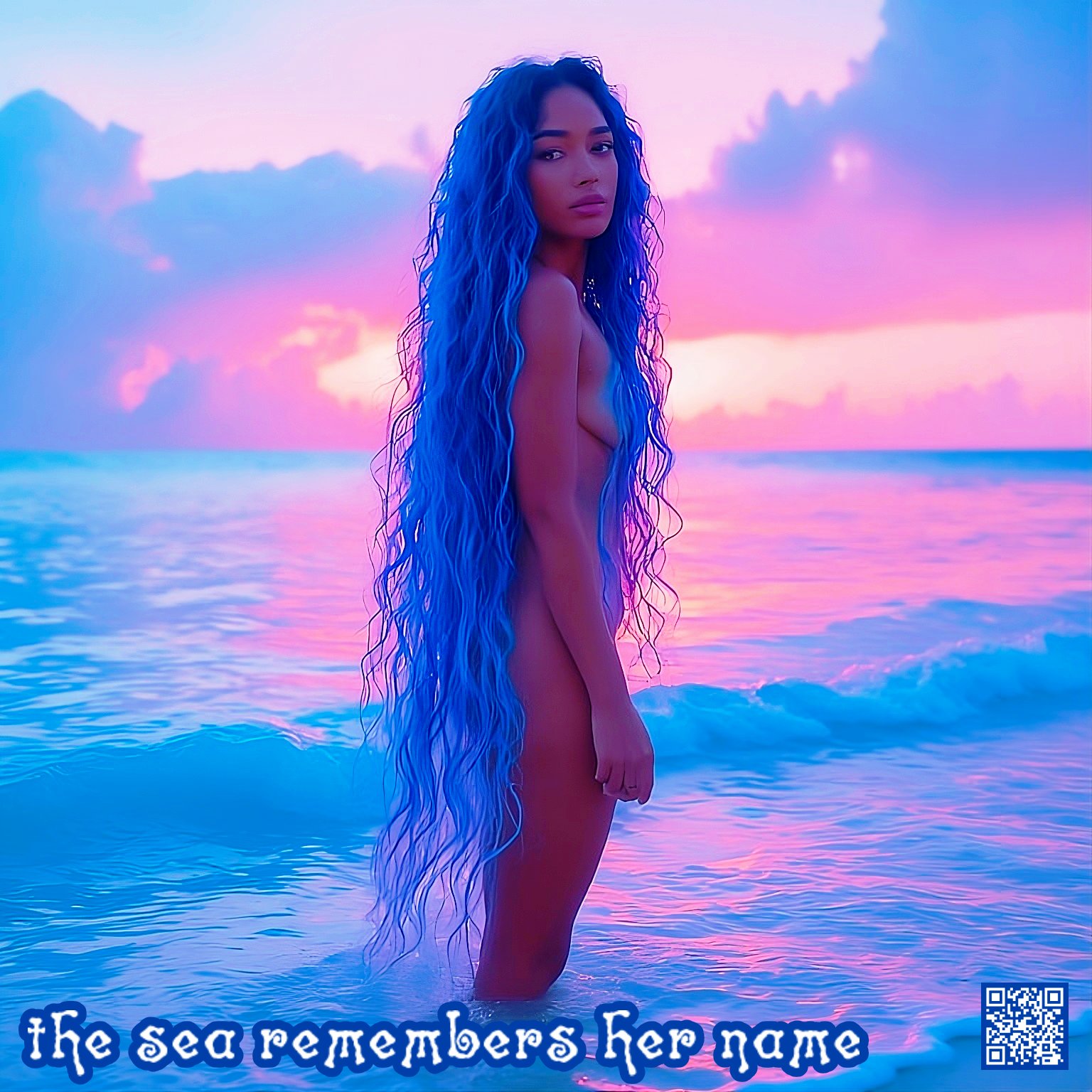
 “I called you Blue Roses because you were different… unusual… rare. You were something special… Something I had never seen before.”
“I called you Blue Roses because you were different… unusual… rare. You were something special… Something I had never seen before.”